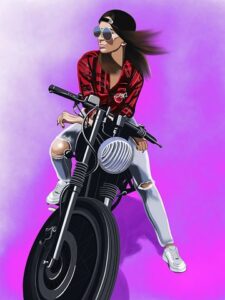In order to write great stories, you need to create three-dimensional characters that your readers can connect with on a deeper level. When it comes to fiction, we often think about the plot and setting, but character development is just as important. If your readers can’t relate to your characters, they won’t stick around for long.
This blog post will discuss why it’s important to create well-rounded characters and how you can make them seem real, physical, psychological and social.
What three-dimensional characters are and why they are essential
Well-done three-dimensional characters are believable and relatable. They feel real, with complex inner lives and rich backstories that we can only begin to imagine.
Another important aspect of creating three-dimensional characters is ensuring they are physically well-rounded. How they look, how they carry themselves, what kind of clothes they wear.
Finally, your characters should also be well-rounded psychologically and socially. What are their thoughts and feelings on the events happening around them? How do they interact with the other people in their lives? These elements will help to make your characters feel like real, complex people.
All these details can help create a more vivid picture of your character in the reader’s mind.
How to make your characters seem real and physical to the reader
One of the best ways to make your characters seem three-dimensional is to give them a rich back story. What kind of childhood did they have? What are their hopes and dreams for the future? What types of experiences have shaped them into who they are today? The more detailed you can make their history, the more accurate they will feel.
Start by giving your characters physical, psychological, and social dimensions.
Physical dimension
You can do a few things to make your characters seem real and physical.
First, pay attention to the details of their appearance. Describe their hair, their build, the colour of their eyes, and the clothes they are wearing. If you’re having trouble coming up with ideas, try looking at photos of people for inspiration.
Second, consider how your character moves. Do they have any distinctive mannerisms? For example, are they athletic, clumsy, or graceful? Is the way they move indicative of their personality or history?
Finally, pay attention to the dialogue you write for your characters. Give your characters distinct mannerisms and speech patterns. Each person should have a distinct way of speaking that reveals their personality. Do they have a high-pitched voice or a soothing voice?
For example, someone always joking around will likely speak differently than someone more serious. It could be the way they gesture when they talk or their particular use of slang or vocabulary.
Psychological dimension
The psychological dimension is all about the character’s mental state. Think about what motivates your character. What drives them to do what they do? Why do they react the way they do to different situations? Are they patient or short-tempered, or shy? What are they afraid of, or what do they like? What are their thoughts and feelings?
Put them in believable situations and let them interact with their environment. For example, what would they do if they spilled something on their shirt? How would they react to someone unexpectedly hugging them? If sitting in a chair, have them shift their position or fidget. Finally, give them personality quirks or tics that make them even more unique and three-dimensional.
Social dimension
People are social creatures. In addition to having their thoughts and motivations, they’re also influenced by the people around them. So when you’re creating characters, think about their relationships with others and how those relationships might shape them. How do they interact with others? Do they have friends, family, or enemies? What kind of relationships do they have? These interactions shape the character and make them who they are.
By doing these things, your characters will come to life on the page and feel like real people to your reader.
Examples of well-done three-dimensional characters

Well-done three-dimensional characters don’t come along very often, but they’re a joy to read when they do.
Some great three-dimensional characters include Lisbeth Salander from the Millennium series, Sherlock Holmes from Arthur Conan Doyle’s stories, Emma Woodhouse from Jane Austen’s Emma, Tony Soprano from The Sopranos, and Walter White from Breaking Bad.
All these characters are multi-layered incredibly complex human beings, evolving tremendously throughout their respective stories. They are not simply one-dimensional villains or heroes; instead, they are fully fleshed-out human beings with strengths and weaknesses like everyone else.
What makes these characters so well-done is that they’re complex and believable. What makes them so compelling and exciting to watch is you can relate to them on some level, even if you don’t necessarily agree with their choices or actions. They are real people with motivations and backstories that shape their decisions.
Another well-done three-dimensional character is Severus Snape from J.K. Rowling’s Harry Potter series – Severus Snape is an excellent example of a well-done three-dimensional character because he constantly evolves throughout the series. He starts as one thing and ends up being something completely different, which makes him both fascinating and unpredictable.
And then there is the famously well-done three-dimensional character Atticus Finch from Harper Lee’s novel, To Kill a Mockingbird.
Atticus is one of those rare characters who is both complex and consistent. He’s a perfect example of a well-done three-dimensional character because he is both admirable and flawed. He is someone that the reader can root for and admire while also acknowledging his faults.
Throughout the novel, we see him display many qualities – wisdom, strength, compassion, and resolve. Yet despite his many complexities and contradictions, he remains true to himself throughout the story. He never wavers from his moral compass, even when it’s not popular or easy to do so.
This makes him an incredibly compelling character to read about. We can’t help but be pulled in by his story and invested in his journey.
Tips for creating a believable, three-dimensional character

Creating compelling three-dimensional believable characters takes careful planning and attention to detail. Here are some tips to help get you started:
– Start by nailing down the basics – who is your character, what do they look like, and what is their personality? The more specific you can be, the better.
– Once you understand your character well, please start thinking about their backstory. What drove them to become who they are today? What are their hopes and fears?
– Then use your character’s backstory to inform their appearance and behaviour in the 3D world. For example, are they fashionable or conservative in their dress? Do they move with purpose or shuffle aimlessly?
Backstory examples
– Let’s say your character’s sister was murdered when they were younger. This event drove your character to pursue a law enforcement career to find her sister’s killer and put them behind bars.
– Or you want to base your story around a detective investigating a crime, then you could create a backstory for your detective character, a deep character, a multi-dimensional character with experience solving complex cases. This would make them the perfect candidate for investigating the crime in your story.
– Or your character is a young girl who grew up in a neighbourhood ridden with violence and poverty. Her mother was killed when she was just a toddler, and her father was never really in the picture. As a result, she turned to a life of crime at a very young age in order to survive. She quickly learned that it was easier to take what she wanted than to try and earn it through honest means. And so began her life as an outlaw.
Your characters must be detailed and nuanced. They should have their own quirks, mannerisms, and backstories, which make them stand out from the rest, but make sure they are relatable. Readers need to be able to see themselves in your characters to invest in them.
One way to achieve this is by giving your characters relatable flaws and challenges. But of course, we all have flaws and face challenges in life, so by writing about these things, you make your characters more human and accessible.
Secondly, your characters should be consistent in their behaviours and actions. If a character suddenly behaves out of character, it will jar the reader and make them less believable.
Finally, good characterization comes from observed human behaviour. If you can accurately capture how people act and interact in the real world, your characters will come to life on the page.
Use dialogue and action to bring your characters to life

One of the best ways to make your characters seem real is to give them dialogue and action that feels natural. You’re on the right track if you can get your readers to feel like they’re right there alongside your characters.
Pay attention to how people talk in real life, and try replicating that in your writing. It doesn’t have to be perfect, but it should give a general sense of how people interact with each other. And as for action, make sure that your characters’ movements make sense in the story context and personalities.
Both dialogue and action can reveal a lot about a character, so use them wisely! By showing how your characters think and behave, you can give readers a much fuller picture of who they are.
For example:
– Paying attention to body language and facial expressions
– Showing what a character is thinking through their inner monologue
– Giving readers glimpses into a character’s backstory or past
– Having other characters react to the way your protagonist thinks and behaves
– Focusing on critical traits or aspects of a character’s personality
Considering all these factors, you can create three-dimensional characters that feel like real people. Readers will be able to connect with them deeply, and your stories will be all the richer for it.
Conclusion
Why should your readers care about three-dimensional characters? Three-dimensional characters are essential to good storytelling. By making them seem natural, physical, psychological and social, you can create stories that are much more compelling and enjoyable for readers. So take the time to develop your characters and make them as rich and exciting as possible! They’re waiting to meet you. 🙂
If you’re working on your first novel and are looking for more help with your writing, please check out my other articles at https://ullahakanson.com/blog/
Happy writing!
Ulla

